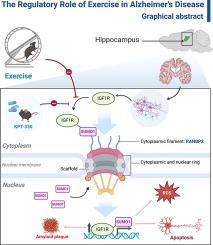运动增强 IGF1R sumoylation 诱导的核转位可减少阿尔茨海默氏症小鼠的神经炎症。
IF 11.4
1区 综合性期刊
Q1 MULTIDISCIPLINARY SCIENCES
引用次数: 0
摘要
本文章由计算机程序翻译,如有差异,请以英文原文为准。


Exercise-Induced Reduction of IGF1R Sumoylation Attenuates Neuroinflammation in APP/PS1 Transgenic Mice
Introduction
Alzheimer's Disease (AD), a progressive neurodegenerative disorder, is marked by cognitive deterioration and heightened neuroinflammation. The influence of Insulin-like Growth Factor 1 Receptor (IGF1R) and its post-translational modifications, especially sumoylation, is crucial in understanding the progression of AD and exploring novel therapeutic avenues.
Objectives
This study investigates the impact of exercise on the sumoylation of IGF1R and its role in ameliorating AD symptoms in APP/PS1 mice, with a specific focus on neuroinflammation and innovative therapeutic strategies.
Methods
APP/PS1 mice were subjected to a regimen of moderate-intensity exercise. The investigation encompassed assessments of cognitive functions, alterations in hippocampal protein expressions, neuroinflammatory markers, and the effects of exercise on IGF1R and SUMO1 nuclear translocation. Additionally, the study evaluated the efficacy of KPT-330, a nuclear export inhibitor, as an alternative to exercise.
Results
Exercise notably enhanced cognitive functions in AD mice, possibly through modulations in hippocampal proteins, including Bcl-2 and BACE1. A decrease in neuroinflammatory markers such as IL-1β, IL-6, and TNF-α was observed, indicative of reduced neuroinflammation. Exercise modulated the nuclear translocation of SUMO1 and IGF1R in the hippocampus, thereby facilitating neuronal regeneration. Mutant IGF1R (MT IGF1R), lacking SUMO1 modification sites, showed reduced SUMOylation, leading to diminished expression of pro-inflammatory cytokines and apoptosis. KPT-330 impeded the formation of the IGF1R/RanBP2/SUMO1 complex, thereby limiting IGF1R nuclear translocation, inflammation, and neuronal apoptosis, while enhancing cognitive functions and neuron proliferation.
Conclusion
Moderate-intensity exercise effectively mitigates AD symptoms in mice, primarily by diminishing neuroinflammation, through the reduction of IGF1R Sumoylation. KPT-330, as a potential alternative to physical exercise, enhances the neuroprotective role of IGF1R by inhibiting SUMOylation through targeting XPO1, presenting a promising therapeutic strategy for AD.
求助全文
通过发布文献求助,成功后即可免费获取论文全文。
去求助
来源期刊

Journal of Advanced Research
Multidisciplinary-Multidisciplinary
CiteScore
21.60
自引率
0.90%
发文量
280
审稿时长
12 weeks
期刊介绍:
Journal of Advanced Research (J. Adv. Res.) is an applied/natural sciences, peer-reviewed journal that focuses on interdisciplinary research. The journal aims to contribute to applied research and knowledge worldwide through the publication of original and high-quality research articles in the fields of Medicine, Pharmaceutical Sciences, Dentistry, Physical Therapy, Veterinary Medicine, and Basic and Biological Sciences.
The following abstracting and indexing services cover the Journal of Advanced Research: PubMed/Medline, Essential Science Indicators, Web of Science, Scopus, PubMed Central, PubMed, Science Citation Index Expanded, Directory of Open Access Journals (DOAJ), and INSPEC.
 求助内容:
求助内容: 应助结果提醒方式:
应助结果提醒方式:


